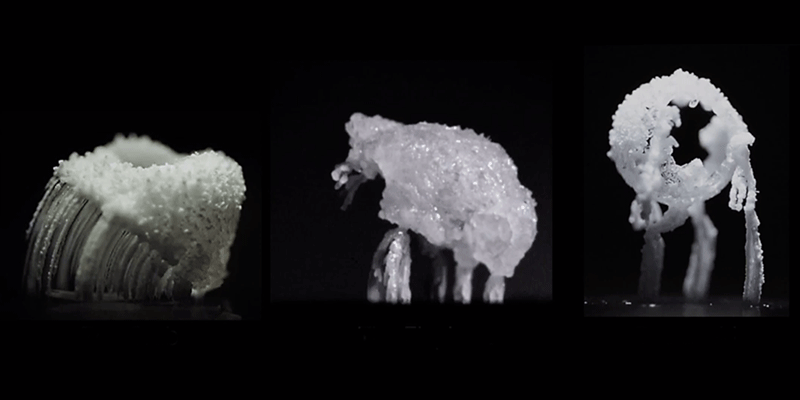Video Prize Dominated by Superhydrophobic Surfaces
Like so many other great discoveries, it happened by accident. Massachusetts Institute of Technology graduate student Samantha McBride was observing tiny droplets of salt water evaporate on a hot, bumpy surface, when she saw miniscule animal figurines, such as elephants and crabs, form out of the salt crystals. “First time I saw it, I was very excited,” she says. The video McBride and her colleagues produced won the 2019 Milton van Dyke Award, the prize given to the top three videos in the APS Division of Fluid Dynamics Gallery of Fluid Motion video contest.
The researchers were studying the problem of salt deposits damaging pipe walls in desalination plants. They started with the basics, creating salt crystals by evaporating salt-saturated water, using a range of salts, surfaces, and temperatures. One surface type they considered was the so-called superhydrophobic surface, which has microscale or nanoscale bumps or other patterns that can strongly repel water. This property can potentially reduce crystal formation from drying drops of salt water. McBride discovered that when she placed a microliter droplet of saturated salt water on a hot superhydrophobic surface, it formed a roughly spherical crystal shell as the water evaporated. But then suddenly, when the water was mostly gone, the shell began to grow legs that gradually lifted the sphere off the surface.
After much experimentation, McBride learned that the legs grow because, once the shell has formed, the remaining water drains to the bottom of the sphere and clings to it both inside and out, preferring to stick to the water-loving salt rather than the superhydrophobic surface. But the liquid still contacts the hot surface at a few isolated points, where the water rapidly evaporates and leaves behind the narrow legs.
Besides making beautiful video, these experiments could potentially lead to ways of reducing corrosion of critical exposed surfaces on ships, such as navigation equipment or elements of the propulsion systems, says MIT engineering professor Kripa Varanasi, McBride’s supervisor. Sea spray hitting a heated superhydrophobic surface could form crystalline structures that simply break off, rather than forming deposits that require periodic cleaning.
The team was able to vary the shapes produced by adjusting parameters such as the salt content and the temperature. Varanasi says that this is a rare case where a nanoscale phenomenon—the interface between the crystalline legs and the solid surface—is controllable by adjusting macroscopic parameters. “Those are the things I love,” he says. “Without doing any crazy precise processes, you’re able to control this phenomenon.”
In creating their video, the team chose the soundtrack, “In the Hall of the Mountain King,” a famous 1875 symphonic piece by Edvard Grieg. “We wanted something kind of dramatic for when the crystal lifts off,” says McBride. Team member and MIT graduate student Henri Girard says the music is “the right combination of beautiful and silly.”
Another van Dyke winner also used superhydrophobic surfaces, in this case to show the surprising behavior of water drops when falling onto such surfaces. Guillaume Durey, of the Lutetium Project and ESPCI Paris and his colleagues showed that a drop hitting a flat superhydrophobic surface bounces back as a mostly intact blob. But if the surface is a cone pointing up, then the drop bounces off as a ring that splits into smaller droplets. With the right choice of cone angle, these droplets shoot out horizontally, because gravity balances the upward reaction force for the surface-drop interaction. “We were pleasantly surprised to observe liquid rings, as they are elusive objects,” says team member Pierre Chantelot of ESPCI Paris. He says that the fragmentation of drops occurs in many situations, so studying it here could, for example, help improve understanding of the dispersion of contaminants in the atmosphere through small drops.
The third van-Dyke-winning video, from Paul Lilin of MIT and his colleagues, also has something in common with McBride’s video—in both cases the researchers demonstrated the artistic results of letting water evaporate. But in Lilin’s video, the fluid is a colloid—water containing silica nanoparticles—rather than salt water. As the film dries, it develops internal stresses that produce symmetric flower patterns in the dry film. The team could control the number of equally-spaced cracks by adjusting the density of colloid particles. “I am fascinated by the rich variety of different patterns that occur in such a seemingly simple system,” says team member Irmgard Bischofberger of MIT. “I mean, it's just a bunch of tiny particles in water.”
–David Ehrenstein
David Ehrenstein is the Focus Editor for Physics.





